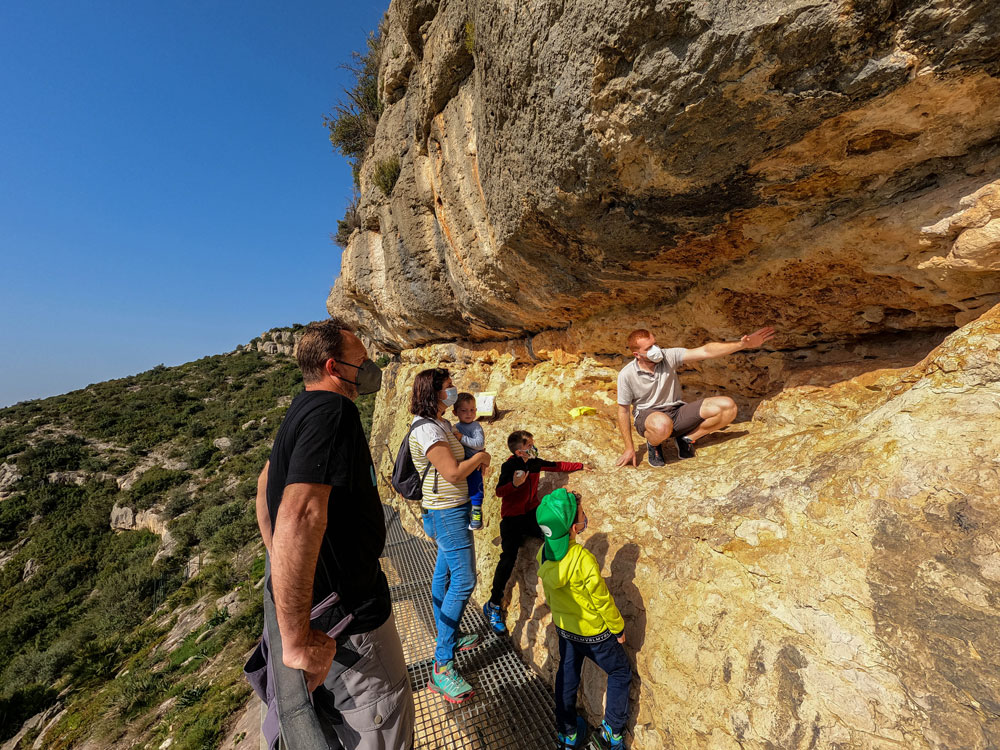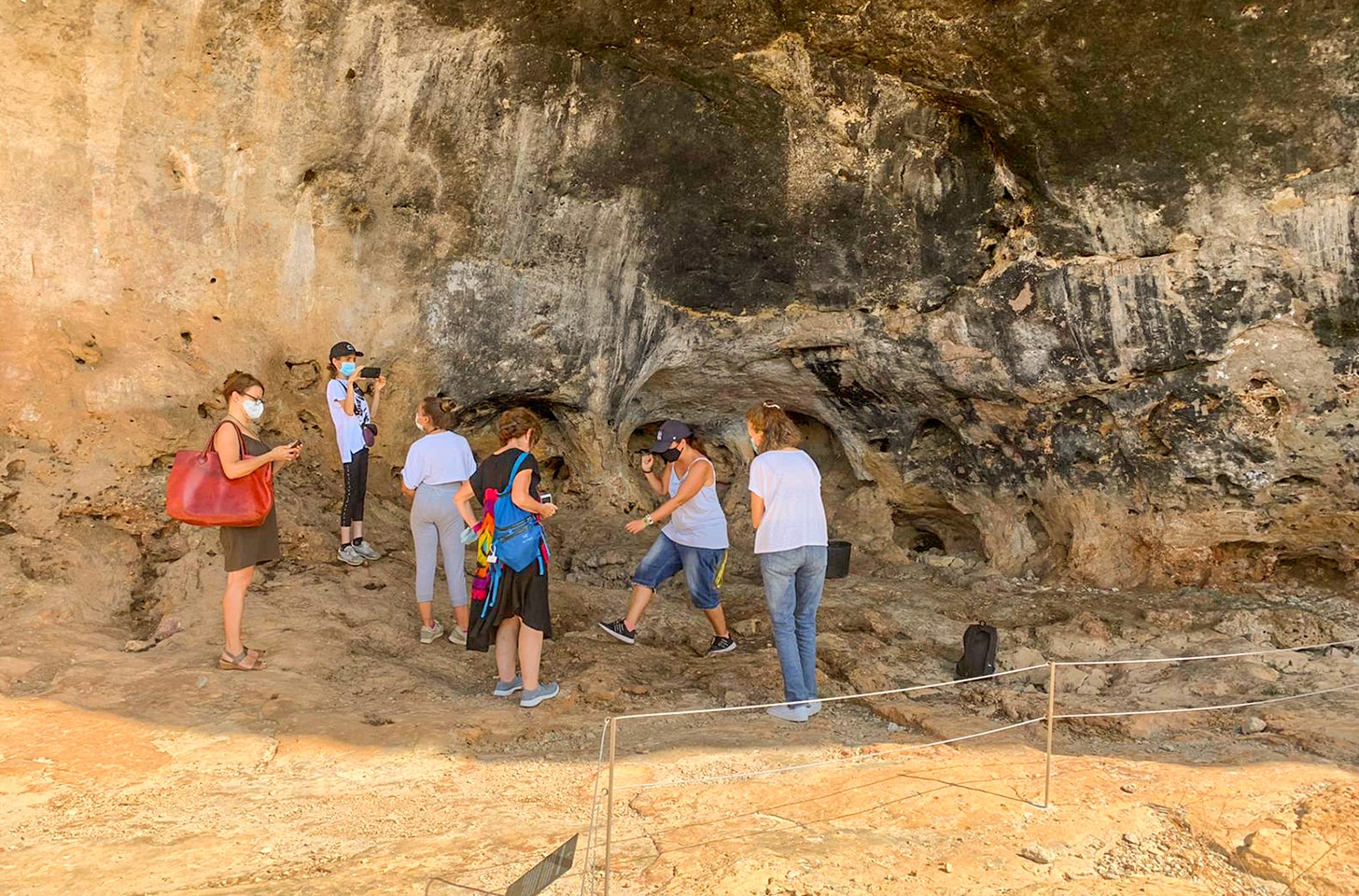EL CONJUNT RUPESTRES

THE CAVE SITE



The cave paintings of the Serra de Godall mountains, declared a World Heritage Site by UNESCO in 1998, are one of the most important series of Levantine Cave Art in the entire Iberian Peninsula. Some of them were painted over 8,000 years ago, during the post-Palaeolithic period. Most of the paintings found so far have been dated to the period known as Levantine art. Schematic and abstract figures have only been found on the walls of the Dark Cave (Shelter IV).


















A visit to the Ulldecona Cave Site provides an opportunity to enjoy the most complex and well-preserved example of Catalan Levantine Art, and one of the most important in the Iberian Peninsula. Its narrative-style scenes, such as the impressive “Oldest Legend in Catalonia” in Shelter I give us some idea of the society, culture and rituals of the first post-Palaeolithic society of 8,000 years ago. In addition, thanks to the new technologies, an “e-Art” augmented reality app can be used in this cave. It lets us reconstruct the scene as it was painted by the artists, gives a better idea of the magnitude of the site, its narrative and artistic complexity, and thereby improves the visitor’s experience.
These paintings reveal a world of beliefs or mythical stories related to hunting and involving part of society, possible heroes or legendary figures, divinities, those in charge of carrying out the rituals and the different species of animals typical of the area. The steep cliffs would have been a perfect setting for capturing animals. Furthermore, it was probably used as a meeting place and a place for celebrating certain rituals.
Painting thus became a means of communication. It marked the most significant points or “sacred” places where ceremonies were held and, at the same time, it allowed the traditions, part of the historical memory and the cultural values of the inhabitants of this territory to be maintained.
The fact that hunting scenes are common in these paintings suggests that they were painted by human groups whose means of subsistence was hunting and gathering. We know from the animal species represented that they were painted between 7000 and 2000 BC. During that period, other communities that practised agriculture and livestock farming developed in this area, with whom they may have been in contact. The community of hunter-gatherers from the Serra de Godall must have moved around this area periodically throughout the year. Throughout the almost 500 metres that the rock art of the Serra de Godall occupies, we can see more than 400 figures distributed unevenly in the different abrics.
Given the difficulty of accessing most of the cave paintings, the “Abrics de l’Ermita” Cave Art Interpretation Centre was created in 2006, designed to bring visitors closer to the numerous remains that the abricas contain. To this end, multiple graphic resources and a large number of photographs and tracings of the paintings have been used to provide the visitor with a very pleasant way of gaining an in-depth knowledge of this legacy. In addition, there is also an interactive game under the title “Nosaltres caçadors” (“We are hunters”) which, apart from its more playful part, brings us closer to the hunting strategies used 8000 years ago by our ancestors. Therefore, this interpretation centre is very interesting to visit.
WHICH VISIT DO YOU PREFER?
CHOOSE THE ONE THAT SUITS YOU BEST
The Cave Paintings + Cave Art Interpretation Centre
The visit starts at the Interpretation Centre, located on the lower floor of the Ermita de la Pietat chapel. Here visitors receive background information on the various types of cave art found all over the world. We will focus on Levantine Art and the Sierra de Godall site, based on texts, various photographs, and audiovisual and multimedia resources.
From there, the tour involves a walk 300 metres down the escarpment to the cave paintings in small groups, until we reach Shelter 1, where our expert guides will take us back in time for a prehistoric experience during a crucial period for mankind in this small cave, which is located about 300 metres along the escarpment south of the Ermita shrine. It contains a magnificent scene depicting hunting that has been very well preserved. It has a clearly naturalistic and narrative style as if it were a mythical tale, and it is known as THE OLDEST LEGEND IN CATALONIA. Its small and detailed figures are laid out strategically, with each hunter and animal playing an important role in the composition as they surround and kill a group of deer and goats which are unsuccessfully trying to run away. The piece’s dynamism and complexity, and the anatomical and dynamic details of its figures are surprising. It is even possible to make out aesthetic and technological features. The scene also includes enigmatic figures including the iconic Wizard, the Deer in Silhouette, and a possible Woman. Visitors can also participate and actively interact with the guided tour using the e-ARt app.
We then visit Shelter IV, known as the Dark Cave. Located in the centre of the site and on the same level, this large cave contains figures in a semi-schematic and schematic-abstract style. These figures of iconic significance are a necessary complement to understanding the site as a whole, its complexity and evolution over a long period of time, and the learning of human graphic communications.
Shelter VIII is open to specialised groups subject to advance booking.
€10 per adult (please enquire about special rates)
Tuesdays to Saturdays at 10:00 am and 5:00 pm
Wednesdays and Fridays also at 7:00 pm
Sundays at 10:00 am
Approximately two hours
If you require a specific language (Catalan, Spanish, English, French, German), please make this clear when making your booking; otherwise the guide will adapt the language of the visit to the needs of the group.
Starting from the lower floor of the Ermita de la Pietat, 4 kilometres from Ulldecona towards Tortosa.
Make your booking with just one CLICK!
Cultural Ulldecona (Ancient Olive Trees + Medieval Castle + Cave Paintings)
This is one of the most popular guided tours, as it highlights three of our town’s most important assets, namely the spectacular L’Arion ancient olive trees, which are genuine living sculptures, with an oil tasting included at the end of the visit; the fabulous Medieval Castle with its different stages of construction and spectacular views; and one of the most complex and well-preserved sites of Levantine Cave Art in the entire Iberian Peninsula.
Adults: €15/person
Children under 10 years old: Free
The Ancient Olive Trees at 10 am.
The Medieval Castle at 12:15 pm / The Cave Site at 4:00 pm.
Approximately 2 hours each visit
It starts at the Tourist Office for the visit to the cave paintings, but it starts from the basement of the Ermita de la Pietat.
Make your booking with just one CLICK!
The Cave Paintings + Cave Art Interpretation Centre + Moleta del Remei
The cave paintings of Ulldecona, declared a UNESCO World Heritage Site, are one of the most important collections of Levantine Cave Art in the Iberian Peninsula. We will visit the Interpretation Centre, Shelter 4 and the spectacular hunting scene in Shelter 1, known as “The Oldest Legend in Catalonia”. Visitors will be able to discover and appreciate this beautiful communicative reflection of our ancestors’ beliefs, myths and legends.
Located on the southern slope of the Montsià mountain range, Moleta del Remei was an Ilercavone fortified settlement dating from the sixth to the second century B.C. Among other socio-cultural aspects, its monumental defensive system and urban planning are evidence that this was an important point for trading products with various peoples from the Eastern Mediterranean, such as the Phoenicians.
Adults: €13/person
10 to 15 years old: €10/person
Children under 10 years old: Free
Approx. 2 hours.
The visit to the Cave Site starts on the lower floor of the Ermita de la Pietat
The starting point for visits to Moleta del Remei is the Ermita del Remei car park.
Make your booking with just one CLICK!
RupArt&Family
An activity for families in which our younger visitors (from 3 to 8 years old), accompanied by their parents, can learn through play what life was like 8,000 years ago in a language adapted for them. The hunting systems used, how the cave figures were painted, what the legends symbolised… They will have a fantastic time enjoying themselves and learning!
Booking at least one day in advance is essential.
Adults: €2/person
Children: €6/person
The first and third Saturday of the month at 6 pm until late September
Approx. 2 hours.
Lower Floor of the Ermita de la Pietat
Make your booking with just one CLICK!













